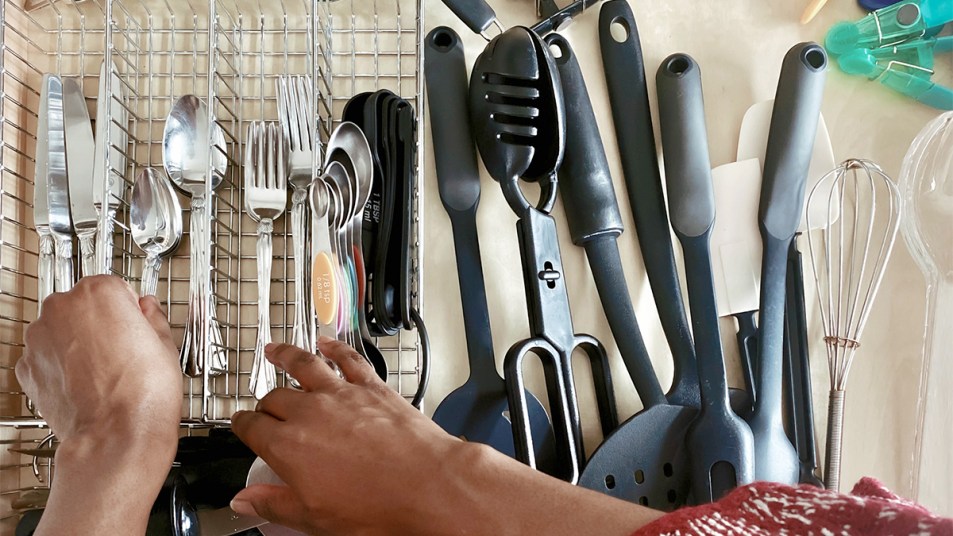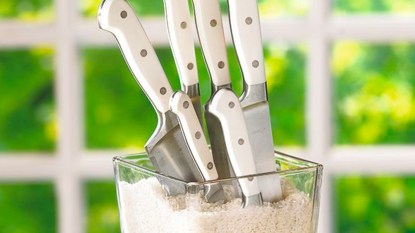5 Tips for Organizing Your Silverware Drawer That Will Make It Look Immaculate

Who knew that something as mundane as organizing your silverware drawer could cause such a stir? But that’s exactly what happened when a user posed an innocent question about how to arrange a silverware drawer on Reddit.
Hundreds of comments ensued, although the majority agreed the silverware drawer should be arranged as follows (left to right): large knives, knives, forks, spoons, and teaspoons at the bottom. Organizational preferences aside, a beautifully organized silverware drawer can make a kitchen more efficient.
Elain Maytom, Senior Showroom Designer at Freedom Kitchens tells us what we’re doing wrong but more importantly, how to get it right.
1. Not Using Drawer Dividers
“Divide and conquer! Dividers like those designed into silverware drawer trays are the best way to keep items separated into logical groupings, making everything easy to spot at a glance,” says Maytom. “Use inserts with variable dividers which are stylish and affordable, and won’t slip and slide around inside the drawer.” Depending on the style of your cabinets, choose colors and finishes to match and a combination of individual trays to make up the best solution for your needs.
2. Too Many Utensils
“We often inherit bits and pieces or accumulate them when we lose something and replace it, only to find the old item later,” says Maytom, who suggests doing a cull of the contents of your silverware drawer before you rearrange it to see exactly what you’re working with. “Sort silverware and utensils into two piles,” she suggests. “Those you like and use regularly (or can see yourself using in the future), and those which you never anticipate using, or don’t like the look of because it doesn’t match anything else.”
“Be brutal when it comes to the old ‘junk drawer.’ The kitchen isn’t the place for it — reserve your kitchen drawers for kitchen items only,” says Maytom. “It makes no sense having three different types of potato peelers or bottle openers — only choose to keep the tools that work best and look good.”
3. The Layout is Confusing
Knives, forks, spoons left-to-right, or right-to-left? Handles in first or facing out? These are questions that can baffle even the most determined de-clutterer!
“There are no hard and fast rules here, and it also depends on the compartments of your silverware tray,” says Maytom. “However most people intuitively work from left to right. If you prefer to lay everything out the way you would a table setting, then go for it — forks on the left, followed by knives with blades facing inwards (or to the left), followed by spoons.”
“It always makes sense to have the handles facing out and nearest to you, so that’s what you grab hold of when taking them out,” she adds.
4. They Throw Everything in Together
“The utensil drawer can quickly get overly cluttered and messy with all of the odd shapes like whisks and wooden spoons, so it’s very handy to have dividers here,” suggests Maytom. “Again have all handles facing out to you, and group like items together — i.e. group baking utensils separately from the everyday cooking utensils. Sharp chef’s knives are best stored in a knife block to avoid any accidents, or making the blades blunt.”
5. Large Items Take Up All the Space
“Try to group like items together where it makes sense,” says Maytom. “For example, your BBQ brush and scraper. Tea towels should have their own dedicated drawer, and it’s also nice to have a separate drawer for your foil, plastic wrap, and parchment paper.”
3 Steps to a Perfect Silverware Drawer:
Assess: Assess all your existing silverware, utensils, and any other odds and ends you currently store in your kitchen drawers by taking them all out, one drawer at a time.
Sort: Sort into groupings of like items. Give away or sell anything you don’t really need — if you don’t use it now or intend to in the future, then it’s just wasting space.
Organize: Place your items back into the drawer trays with dividers, keeping the groupings together as much as possible. You can make an exception where it makes sense according to the size of the compartments.
This article originally appeared on our sister site, Homes to Love.













